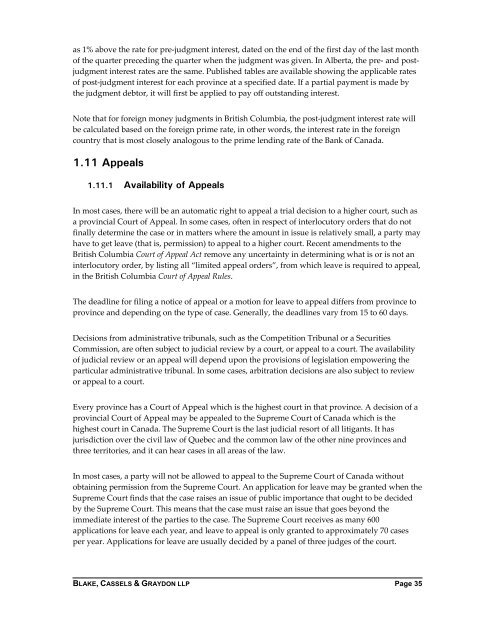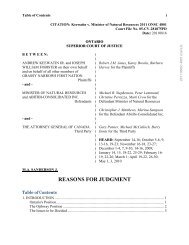as 1% above the rate for pre-judgment interest, dated on the end of the first day of the last monthof the quarter preceding the quarter when the judgment was given. In Alberta, the pre- <strong>and</strong> postjudgmentinterest rates are the same. Published tables are available showing the applicable ratesof post-judgment interest for each province at a specified date. If a partial payment is made bythe judgment debtor, it will first be applied to pay off outst<strong>and</strong>ing interest.Note that for foreign money judgments in British Columbia, the post-judgment interest rate willbe calculated based on the foreign prime rate, in other words, the interest rate in the foreigncountry that is most closely analogous to the prime lending rate of the Bank of Canada.1.11 Appeals1.11.1 Availability of AppealsIn most cases, there will be an automatic right to appeal a trial decision to a higher court, such asa provincial Court of Appeal. In some cases, often in respect of interlocutory orders that do notfinally determine the case or in matters where the amount in issue is relatively small, a party mayhave to get leave (that is, permission) to appeal to a higher court. Recent amendments to theBritish Columbia Court of Appeal Act remove any uncertainty in determining what is or is not aninterlocutory order, by listing all “limited appeal orders”, from which leave is required to appeal,in the British Columbia Court of Appeal Rules.The deadline for filing a notice of appeal or a motion for leave to appeal differs from province toprovince <strong>and</strong> depending on the type of case. Generally, the deadlines vary from 15 to 60 days.Decisions from administrative tribunals, such as the Competition Tribunal or a SecuritiesCommission, are often subject to judicial review by a court, or appeal to a court. The availabilityof judicial review or an appeal will depend upon the provisions of legislation empowering theparticular administrative tribunal. In some cases, arbitration decisions are also subject to reviewor appeal to a court.Every province has a Court of Appeal which is the highest court in that province. A decision of aprovincial Court of Appeal may be appealed to the Supreme Court of Canada which is thehighest court in Canada. The Supreme Court is the last judicial resort of all litigants. It hasjurisdiction over the civil law of Quebec <strong>and</strong> the common law of the other nine provinces <strong>and</strong>three territories, <strong>and</strong> it can hear cases in all areas of the law.In most cases, a party will not be allowed to appeal to the Supreme Court of Canada withoutobtaining permission from the Supreme Court. An application for leave may be granted when theSupreme Court finds that the case raises an issue of public importance that ought to be decidedby the Supreme Court. This means that the case must raise an issue that goes beyond theimmediate interest of the parties to the case. The Supreme Court receives as many 600applications for leave each year, <strong>and</strong> leave to appeal is only granted to approximately 70 casesper year. Applications for leave are usually decided by a panel of three judges of the court.BLAKE, CASSELS & GRAYDON LLP Page 35
1.11.2 St<strong>and</strong>ard of ReviewOn appeals, different st<strong>and</strong>ards of review are applied to different kinds of cases. Appeal courtsgrant different levels of judicial deference to the lower court or tribunal depending on the issue inquestion. However, some useful generalizations can be made.An appeal court will rarely overturn findings of fact made at a trial by a jury or a trial judge. Afinding of fact at trial is only to be overturned on appeal if it was plainly wrong, <strong>and</strong> there was a“palpable <strong>and</strong> overriding error”. Accordingly, most appeals from lower court decisions areconcerned with whether the court or tribunal below made an error in interpreting or applying thelaw, <strong>and</strong> the st<strong>and</strong>ard of review is one of correctness, that is, the appeal court must be satisfiedthat the lower court correctly applied the law, <strong>and</strong> may reverse the lower court decision if therewas an error.The situation is more complicated with respect to appeals from expert administrative tribunals,such as the Competition Tribunal or a Securities Commission. In those cases, the st<strong>and</strong>ard ofreview will depend on the legislative intent in conferring jurisdiction on the administrativetribunal. The analysis must consider a number of questions, such as the tribunal’s role orfunction, whether the agency’s decisions are protected by a privative clause, that is, a legislativeprovision stating that the tribunal’s decisions are not subject to appeal, <strong>and</strong> whether the questionin issue goes to the tribunal’s jurisdiction.In 2008, the Supreme Court of Canada issued a decision which reformulated the st<strong>and</strong>ard ofreview for the decisions of administrative tribunals. The Supreme Court implemented twost<strong>and</strong>ards of review — correctness <strong>and</strong> reasonableness. Judicial deference to the tribunal’sdecision will be at its highest, <strong>and</strong> the st<strong>and</strong>ard of review will be whether the tribunal’s decisionwas reasonable where, for example, there is a privative clause in the legislation that directs thecourts to show deference to the tribunal’s decision, or where the tribunal was making anadministrative decision based on special expertise (labour relations, for instance). The courtssubstitute their own view of the correct answer, <strong>and</strong> show no deference to the decision of anadministrative tribunal, where the question at issue is one of general law “that is both of centralimportance to the legal system as a whole <strong>and</strong> outside the adjudicator’s specialized area ofexpertise”. See also Section IV, “Regulatory Agencies <strong>and</strong> Tribunals”.1.12 Enforcing JudgmentsOnce a final judgment has been obtained, there are a variety of steps that a judgment creditor(that is, a person who is owed money as a result of a court order) may take to enforce thejudgment. Those steps include investigation, seizure <strong>and</strong> sale of the debtor’s real <strong>and</strong> personalproperty, <strong>and</strong> garnishment of wages <strong>and</strong> other debts. The responsibility for enforcing thejudgment rests on the judgment creditor.Judgment creditors do not, by virtue of their judgments, achieve any priority status (as against,for example, secured creditors). If the judgment debtor (that is, the person who owes money as aresult of a court order) has little or no assets, the judgment creditor may find it impossible toPage 36BLAKE, CASSELS & GRAYDON LLP
- Page 1 and 2: Litigation andDispute Resolutionin
- Page 4: 2.4 Burden of Proof ...............
- Page 7 and 8: criminal matters. The Superior Cour
- Page 9 and 10: II. ISSUES SPECIFIC TONON-CANADIAN
- Page 11 and 12: The money of account is the amount
- Page 13 and 14: Canadian courts give strong deferen
- Page 15 and 16: Parties, however, can agree at any
- Page 17 and 18: • The subject-matter of the dispu
- Page 19 and 20: Canada has negotiated an MLAT with
- Page 21 and 22: action to be commenced by way of a
- Page 23 and 24: exception of documents that are pri
- Page 25 and 26: documents with the court including
- Page 27 and 28: There are obvious limitations on th
- Page 29 and 30: • Compel a plaintiff to post coll
- Page 31 and 32: One mechanism used by Canadian cour
- Page 33 and 34: the timing and length of trial, and
- Page 35 and 36: 1.8.5 Costs in Class ProceedingsSee
- Page 37 and 38: Canadian jurisprudence is not unani
- Page 39: 1.10.2 Foreign Currency JudgmentsCo
- Page 43 and 44: can be sold, and others have waitin
- Page 45 and 46: Quebec, the application or motion t
- Page 47 and 48: adjudicated the common issues, then
- Page 49 and 50: and with whether the decision falls
- Page 51 and 52: authority to conduct administrative
- Page 53 and 54: government permit, often generates
- Page 55 and 56: the CITT are given considerable wei
- Page 57 and 58: mediate and resolve disputes after
- Page 59 and 60: There are also circumstances in whi
- Page 61 and 62: VI. DOMESTIC ARBITRATIONThere is an
- Page 63 and 64: specify the rules of procedure that
- Page 65 and 66: VII. TYPICAL CIVIL CLAIMSWhile ther
- Page 67 and 68: 1.8 Other RestrictionsStatutory lim
- Page 69 and 70: In circumstances where there may be
- Page 71 and 72: • Destruction or delivery up of t
- Page 73 and 74: 4.6 DamagesIn defamation cases, dam
- Page 75 and 76: VIII.QUEBEC LAW AND PROCEDURE1. Ove
- Page 77 and 78: Where the debtor fails to perform h
- Page 79 and 80: To blunt the impact of the generali
- Page 81 and 82: (that is, a complete indemnity), in
- Page 83 and 84: OFFICE LOCATIONSMONTRÉAL600 de Mai
















